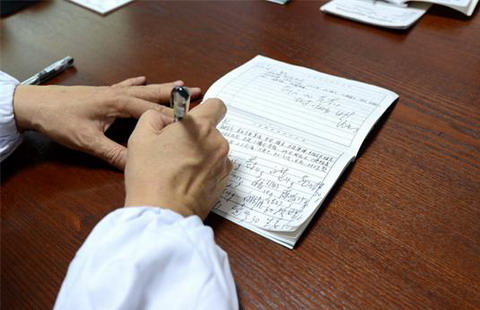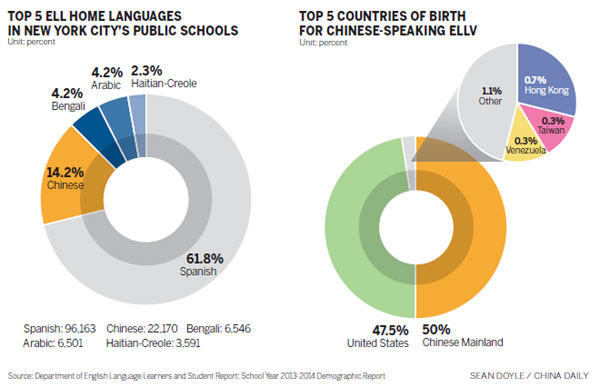Battling the language barrier
Updated: 2015-04-10 11:48
By Niu Yue(China Daily USA)
|
||||||||
Low-income families
Children from low-income families - no matter what their ethnic or racial background - will be exposed to 30 million fewer words than peers from more affluent families in the first four years of their lives, according to a study published in 2003 in the academic journal American Educator. The gap will linger, and even when children from poor families reach high school they may still lack the basic vocabulary to read advanced textbooks.
Shari Levine, executive director of Literacy Inc, which helps children with literacy problems, told New York Public Radio WNYC that even speaking to children in their native language helps build their English proficiency, but immigrant parents, often struggling to make ends meet, are either too busy to do so or not aware of it.
Phyllis Tam, the principal of Dr Sun Yat-sen Middle School, or MS131, in Manhattan's Chinatown, said about 80 percent of her students are Chinese, and around half of them are ELLs.
Some parents have recently moved to New York City, and their children have seldom received proper English-language instructions, and the schools they once attended may have lacked proper ELLs programs, she explained.
"Their English could be only like [that of] a beginner, like they have only been here a couple of months," said Tam. "Verbally, they might be better. In terms of science and when you ask them to read and write, you will see problems."
Tam said some parents who don't have enough time to raise their children send them back to China. "The parents have their hardships. Who am I to say that you shouldn't send them back," she said.
Asian Americans have the highest poverty rate among all ethnic groups in the New York City, according to a report published in April 2014 by the Center for Economic Opportunity from the Mayor's Office. The poverty rate among Asian Americans in 2012, the latest data available, was 29 percent, compared with 14 percent for non-Hispanic whites, 22.5 percent for blacks and 25.7 percent for Hispanics.
Poverty impact
Working but Poor, a research report published in 2008 by the Asian American Federation (AAF), a non-profit research organization on Asian-American communities, said that among Asian children aged 5 to 17 in poverty, 32 percent had limited English proficiency, while the rate for Asian children not from low income was 15 percent. AAF hasn't updated the data yet, but Howard Shih, AAF's research director, said the picture remains largely the same.
"The Chinese community still sees a lot of new immigrants coming in, so they face the same challenges as earlier," he said. The organization is advocating universal pre-kindergarten programs so children can be exposed to English earlier.
In the past, those enrolled in ELLs didn't experience difficulties with English-language proficiency in math because less English was involved. However, now in Common Core Standards, or the standards students are supposed to reach at the end of each grade in English literature arts and math, students must apply "mathematical ways of thinking to real-world issues and challenges."
Instead of 2 X 8 X 4, students would have to deal with what Susan struggled with: "Dan has 2 photo albums. Each photo album has 8 pages. Dan can fit 4 pictures on each page. How many pictures can Dan fit in the albums?"
"A lot of times they are able to be very quick in calculation, but the thing is in the explanation part," said Bonnie Mak, a teacher at PS001. "You cannot get the problem if you don't understand what the problem is asking you for. That's the most challenging thing for ELLs, because they are [still] acquiring the language themselves."
Angela Tse, program coordinator of educational programs with Apex for Youth, told China Daily that they were trying to give as many sessions as possible before the statewide math test. The tutor-student ratio is also smaller than ordinary classes, usually two or three students with one tutor so that they can get more attention.
These sessions are only around two to three hours per week, and the New York public school system is also trying to help. Besides English-literacy courses, there are also at least 42 bilingual programs in the city's public schools and more are planned.
One type of bilingual program is transitional bilingual education, and there are 33 of them for Chinese in New York. In these programs, students are first taught lessons meeting Common Core Standards in their native language.
Chenhui Lin, the Chinese program coordinator of the Native Language Arts department at Newcomers High School in Long Island City, Queens, is teaching literature in Chinese, as part of the school's transitional bilingual program.

 National festival underway with cherry blossoms
National festival underway with cherry blossoms
 Hillary Clinton's China connections
Hillary Clinton's China connections
 Bicycle-friendly Hainan hotels cater to riders
Bicycle-friendly Hainan hotels cater to riders Stars dazzle at 2015 MTV Movie Awards
Stars dazzle at 2015 MTV Movie Awards
 Top 10 best airlines in the world
Top 10 best airlines in the world
 Can doctors' illegible handwriting be justified?
Can doctors' illegible handwriting be justified?
 Take home as many as you like
Take home as many as you like
 Weifang holds kite fair
Weifang holds kite fair
Most Viewed
Editor's Picks

|

|

|

|

|

|
Today's Top News
Hilary Clinton launches presidential campaign
'No room' for election China-bashing: US politicians
AVIC buys Calif. aviation parts distributor
Protests across Brazil seek ouster of president
US backs China's campaign to hunt down fugitives
Obama, Castro hold historic meeting, vow to turn the page
Living Buddha talks Tibet
Consulate general praises C-100 on 25th anniversary
US Weekly

|

|








